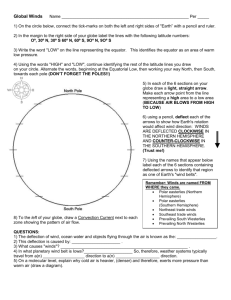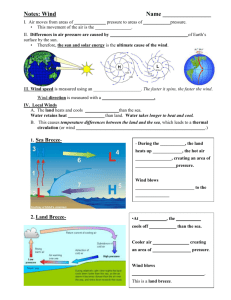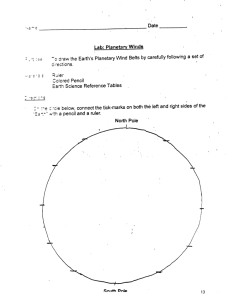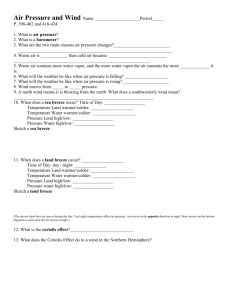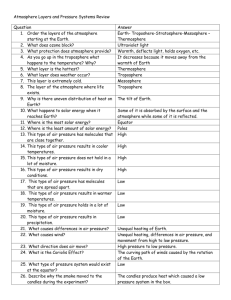Lec 21
advertisement
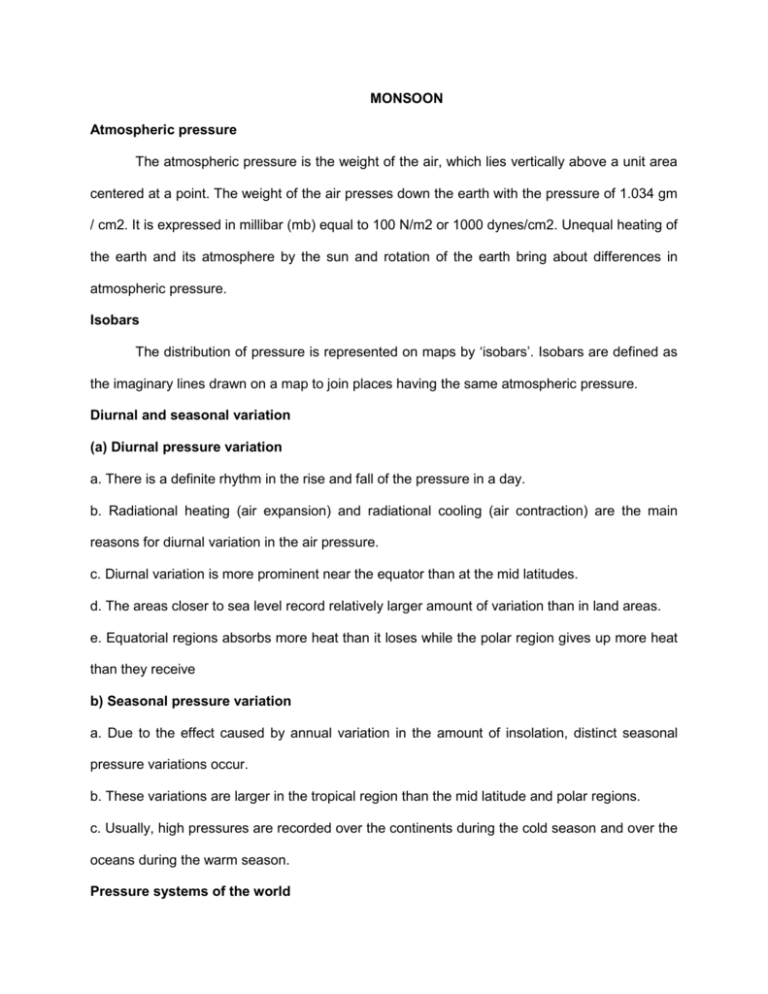
MONSOON Atmospheric pressure The atmospheric pressure is the weight of the air, which lies vertically above a unit area centered at a point. The weight of the air presses down the earth with the pressure of 1.034 gm / cm2. It is expressed in millibar (mb) equal to 100 N/m2 or 1000 dynes/cm2. Unequal heating of the earth and its atmosphere by the sun and rotation of the earth bring about differences in atmospheric pressure. Isobars The distribution of pressure is represented on maps by ‘isobars’. Isobars are defined as the imaginary lines drawn on a map to join places having the same atmospheric pressure. Diurnal and seasonal variation (a) Diurnal pressure variation a. There is a definite rhythm in the rise and fall of the pressure in a day. b. Radiational heating (air expansion) and radiational cooling (air contraction) are the main reasons for diurnal variation in the air pressure. c. Diurnal variation is more prominent near the equator than at the mid latitudes. d. The areas closer to sea level record relatively larger amount of variation than in land areas. e. Equatorial regions absorbs more heat than it loses while the polar region gives up more heat than they receive b) Seasonal pressure variation a. Due to the effect caused by annual variation in the amount of insolation, distinct seasonal pressure variations occur. b. These variations are larger in the tropical region than the mid latitude and polar regions. c. Usually, high pressures are recorded over the continents during the cold season and over the oceans during the warm season. Pressure systems of the world The shape of the earth is not uniform and subjected to uneven distribution of solar radiation, when it revolves around the sun. The uneven distribution of solar radiation over different regions of the globe leads to contrast in surface air temperature. This results in variations of surface atmospheric pressure systems, which are known as standard atmospheric pressure systems / belts. There are altogether seven alternating low and high pressure belts on the earth’s surface. They are as follows: i. Equatorial trough of low pressure (between 5°N and 5°S) ii. Subtropical high pressure belt (Northern hemisphere) (25° and 35°N) iii. Subtropical high pressure belt (Southern hemisphere) (25° and 35°S) iv. Subpolar low pressure belt (Northern hemisphere) (60° and 70°N) v. Subpolar low pressure belt (Southern hemisphere) (60° and 70°S) vi. Polar high (Northern hemisphere) vii. Polar high (Southern hemisphere) The equatorial region receives more solar radiation and thus the surface air temperature is high, which creates lighter air near the ground compared to higher latitudes. The above condition leads to low atmospheric pressure over the equatorial region while sub tropical high pressure belts develop in both the hemispheres between 25 and 35 degree latitudes due to relatively low surface air temperature. It is due to low solar radiation received due to inclined sun’s rays over the subtropical region when compared to the equatorial belt. Like wise alternate low and high atmospheric pressure belt systems are developed across the globe from the equator to the poles. Causes of variation The atmospheric pressure changes continuously due to several factors. The most important factors are changes with temperature, altitude, water vapour content and rotation of earth. a) Temperature Hot air expands and exerts low pressure. Cold air contracts and exerts high pressure. So the equator has a low pressure due to prevalence of high temperature but poles have a high pressure. b) Altitude At sea level, the air column exerts its full pressure, but when we stand on a hill or when we go in the upper layers of atmosphere, we leave a portion of air which cannot exert its full pressure. At sea level, a coastal town enjoys high pressure but on high altitude one will register a low pressure. For every 10 m of ascend, the pressure get reduced by 1 hPa. c) Water vapour The water vapour content is lighter in cold area than in air which is dry with the result that moist air of a high temperature exerts a less pressure when compared to cold air. d) Rotation of the earth On account of rotation of the earth, the pressure at 60-70°N and S becomes low. The rotation of the earth near sub-polar belts, makes the air to escape from these belts which move towards the horse latitude (30° - 35°N and 30 – 35°S). These latitudes absorb the air from sub polar belts making the pressure high. G.D.Coriolis (1844) a French Mathematician indicated that air is deflected towards right in the Northern Hemisphere and Left in the Southern hemisphere due to rotation of earth and this was termed after him as Coriolis force. Coriolis force is not actually a force but it is effect created by rotation of earth. Low / Depression When the isobars are circular or elliptical in shape, and the pressure is lowest at the centre, such a pressure system is called ‘Low’ or ‘Depression’ or ‘Cyclone’. The movement will be anti-clockwise in the Northern hemisphere while it is clockwise in the southern hemisphere. Wind spped hardly exceeds 40 km per hour. Anticyclone When isobars are circular, elliptical in shape and the pressure is highest at the centresuch a pressure system is called ‘High’ or ‘Anticyclone’. When the isobars are elliptical rather than circular the system is called as ‘Ridge’ or ‘Wedge’. The movement will be clockwise in the Northern hemisphere while it is anti-clockwise in the southern hemisphere. Storm Low pressure centre surrounded by winds having their velocities in the range of 40 to 120 km/hour. A more favourable atmosphere condition for their occurrence exists during the summer season. The Bay of Bengal and Arabian sea offer ideal condition for origin and growth of the storms. These storms produce heavy precipitation and bring about a change in the existing weather. It occurs very rarely. It causes wide spread damage. Hurricane A severe tropical cyclone with wind speed exceeding 120 km per hour. The name hurricane is given to the tropical cyclones in the North Atlantic and the eastern North Pacific Ocean. The tropical cyclones of Hurricane force in the western North pacific are known as typhoons. In Australia this type of storm is given the name willy-willy, whereas in the Indian Ocean they are called as Cyclones. Hurricanes are fueled by water vapour (i.e.) pushed up from the warm ocean surface, so they can last longer and sometimes move much further over water than over land. A combination of heat and moisture along with the right wind conditions can create a new hurricane. Thunderstorms Storms produced by cumulonimbus clouds and always accompanied by lightening and thunder. They are usually of short duration, seldom over 2 hours. They are also accompanied by strong wind gusts, heavy rain and sometimes hail. Tornadoes Defined as a violently rotating column of air attended by a funnel-shaped or tubular cloud extending downward from the base of cumulonimbus cloud. Tornadoes are the most violent storms of lower troposphere. They are very small in size and of short duration. They mostly occur during spring and early summer. They have been reported at widely scattered locations in the mid latitudes and tropics. Crop losses are heavy due to this event. Unknown in other parts of the world. Waterspouts It is column of violently rotating air over water having a similarity to a dust devil of tornado. In other words, tornadoes are weak visible vortices occurring over water are called waterspouts. They are formed over tropical and subtropical oceans. Wind Air in horizontal motion is known as wind. Vertical movement is noticed but negligibly small compared to horizontal movement as the height of the atmosphere is only for few kilometers. However vertical movement or uplift of air only causes significant weather changes in cloud formation and rain. Wind systems of the world The wind belts found on earth’s surface in each hemisphere are: a. Doldrums b. Trade wind belt c. Prevailing westerlies d. Polar easterlies 1. Doldrums Owing to continuous heating of the earth by insolation, pressures are low and winds converge and rise near the equator. This intertropical convergent zone is known as ‘Doldrums’. a) These are the equatorial belts of calms and variable winds. b) The location is 5°S and 5°N latitudes. c) Wind is light due to negligible pressure gradient. d) Mostly, there are vertical movements in the atmosphere. e) The atmosphere is hot and sticky. 2. Trade winds (Tropical Easterlies) a) The regular high temperature at the equator results in a high pressure forming in the upper levels of the equator. b) Then, the air is transferred to the northward and southward directions until 35° North and South in both the hemisphere. c) Due to this reduction in surface pressure on the equator (doldrums) there is an increase in pressure at 35°N and 35°S which are known as horse latitude (sub-tropical high). d) As a result, the winds flow from the horse latitude to the equatorial region. e) While moving, these winds are deflected by Coriolis force to the right in northern hemisphere and to the left in southern hemisphere. f) These winds flow from 35°N to the equator in NE direction in the northern hemisphere and from 35°S to the equator in SE direction in the southern hemisphere. These are known as ‘Trade winds’. These are known as ‘Tropical easterlies’. g) These are most constant winds in force and direction and flow over nearly half the globe. 3. Anti-trade winds a) This is a supplementary wind system of the earth which is effective at higher levels. b) This system works in opposite direction to the surface winds. c) The anti-trade winds mostly flow from land to ocean and brings no rain. 4. Prevailing Westerlies a) The winds that flow from sub-tropical high to the low-pressure area about 60-70° latitudes in both the hemispheres are known as ‘Prevailing westerlies’. b) In the northern hemisphere the direction of Prevailing westerlies is SW and in southern hemisphere NW. c) These winds are forceful and are irregular as compare to the trade winds in the tropical regions. d) High precipitation zone 5. Polar Easterlies / Polar winds b) A permanent high pressure exists on the poles. c) From these high pressure polar regions, cold winds flow to areas at about 60-65° latitudes in both the hemispheres. d) The winds flow in NE direction in the northern hemisphere and in SE direction in the southern hemisphere. Mountain winds a) Blows from mountain up slope to base b) Occurs during night time c) Cooling of air close to slope takes place d) Adiabatic heating decreases this phenomenon e) Also known as ‘Katabalic winds’ Valley winds a) Blow from valley base to up slope. b) Occurs during day time c) Over heating of air adjacent to slope takes place d) Adiabatic cooling decreases this phenomenon e) Also known as ‘Anabatic winds’ Sea breeze During the daytime, more so in summer, land is heated more than the adjacent body of water. As a result warmed air over the land expands producing an area of low pressure. The isobaric surfaces bend upward as a result of which the cooler air starts moving across the coast line from sea to land. This is the ‘Sea breeze; or ‘On shore breeze’. Land breeze At night because of nocturnal radiation land is colder than adjacent sea and the pressure gradient is directed from land to sea. There is a gentle flow of wind from land to sea. This ‘offshare’ wind is called ‘Land breeze’. Sl. Sea Breeze Land Breeze 1. Occurs in day time Occurs in night time 2. Flows from sea Flows from land 3. Have more moisture than land breeze Do not have more moisture 4. Occurrence depends on topography of Occurrence depends on Of coast to greater extent on topography of land to little extent 5. 6. Modifies weather on hot summer Produces cooler winters and afternoon warmer summers Stronger than land breeze Weaker than sea breeze Effect of wind on crop plants 1) Transports heat in either sensible or latent heat form from lower to higher altitudes 2) Wind affects the plant directly by increasing transpiration and the intake of CO 2 and also causes several types of mechanical damage. 3) Wind helps in pollination and dispersal of seeds. 4) Light and gentle winds are helpful for cleaning the agricultural produce. 5) Hot dry winds frequently do much damage to vegetation in the growing crops by promoting excessive water loss. 6) Wind has powerful effect on humidity. 7) Long, continued warm, dry winds injured blossoms by evaporating the secretion of the stigma. 8) Provides moisture which is necessary for precipitation 9) Wind prevents frost by disrupting atmospheric inversion 10) Causes soil erosion Wind speed in different season Winds represent air in motion. The primary cause of all winds is regional differences in temperature, producing regional differences in pressure. When these pressure differences persist for several hours, the rotation of the earth modifies the direction of motion, till the winds blow along lines of equal pressure. Wind direction and speed are modified frequently due to seasonal variation in solar radiation and differential heating of the earth’s surface. Wind Speed The winds are generally measured over level, open terrain at 3 meters above ground. Yet, a general idea of the distribution of the mean daily wind speed, on an annual basis as well as on a monthly basis, would be useful. The mean daily wind speed is the value obtained by averaging the wind speed (irrespective of direction) for a whole day. This averaged for all the days of a month is the mean daily wind speed for that month. The daily values averaged for all the 365 days of the year is the annual mean daily wind speed. Wind Direction Winds are always named after the direction they come from. Thus, a wind from the south, blowing towards north is called south wind. The wind vane is an instrument used to find out the direction of the wind. Windward refers to the direction wind comes from, and leeward refers to the direction it blows to. When a wind blows more frequently from one direction than from any other, it is called a prevailing wind. South West Monsoon wind direction During South West Monsoon period of June to September, the westerly winds prevail on the west of Kerala and south winds on the west of northern Circars, Orissa and Bengal. During April and May the region of high temperature is shifted to north viz., upper Sind, lower Punjab and Western Rajasthan. This area becomes the minimum barometric pressure area to which monsoon winds are directed. North East Monsoon wind direction During North East Monsoon period of October to December, on account of the increase in barometric pressure in Northern India, there is a shift in the barometric pressure to the South East and North Easterly winds begin to flow on the eastern coast, by the end of September. These changes bring on heavy and continue rainfall to the Southern and South Eastern India. Winter Rainfall It is restricted more to Northern India and is received in the form of snow on the hills and as rains in the plains of Punjab, Rajasthan and central India. Western disturbance is a dominant factor for rainfall during these months in northwestern India. Summer Rainfall The summer Rainfall is received from March to May as local storms. It is mostly received in the South East of Peninsular and in Bengal. Western India does not generally receive these rains.

